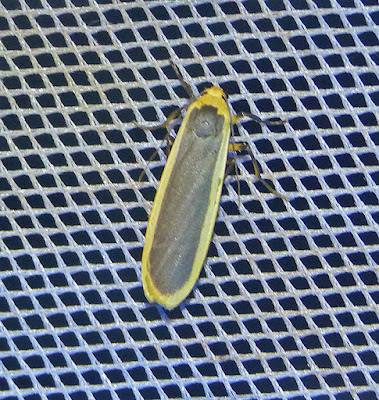Praying Mantises are among the most recognised of insects. They have the reputation of being "good guys" because they eat other insects and that makes them beneficial. A world catalogue of mantises (or mantids, if you prefer) can be found on the Mantis Species File:
http://mantodea.speciesfile.org/HomePage/Mantodea/HomePage.aspx
Australia has a substantial diversity of mantids. They occur in most habitats and have varied life styles. Here in the rainforest we have a number of species that you don't see elsewhere--out in the open woodlands, for example. But many of them seem to occur in both habitats.
In the first instance below, the family, subfamily and tribe are listed just to show the diversity in just the few species noted.
The delicate
Neomantis australis Sasuure and Zehntner; Iridopterygidae; Tropidomantinae; Tropidomantini spends its life on and under leaf surfaces where it hunts for small insects. It seldom strays from rainforest habitats.
Calofulcinia oxynota LaGreca: Iridopterygidae; Neomantinae; Fulcini is a tree running mantis. It spends most of its time hunting on tree trunks. It has also been found on large moss-covered rocks. Its colour and pattern camouflages it quite well under such conditions.
Metoxypilus costalis Westwood: Amorphoscelidae; Paraoxypilinae; Paraoxypilini is an infrequent visitor to lights in Kuranda. It may be associated with termite mounds.
Kongobatha diademata Hebard; Iridopterygidae; Tropidomantinae; Tropidomantini is a fast-moving little mantis that lives in both the rainforest habitat but can also be found on shrubbery in open woodland habitats where it can be quite dry.
Kongobatha diademata Hebard
The little Garden Mantis,
Orthodera ministralis Fabricius; Mantidae; Orthoderinae is quite common across much of Australia. But probably when it is studied thoroughly, a number of distinct species will be unmasked. This mantis comes to lights in the rainforest as well as in some of the driest places in the tropics.
This nymph of the Garden mantis may turn green on its last moult. Here it waits in ambush on a dry grass stem at night in the mixed woodland not far from Kuranda.
Taxonomists use a wide variety of characters in determining mantis species. This Garden Mantid provides an example.
The inner surface of the left foreleg carries a number of distinctive characters. The pattern of spination is important in placing the mantid to family. Since mantids are highly visually-oriented in their behaviour, the colour and patterns on the inside of the forelegs are used in recognition. The colour and pattern seems species-specific and provide useful characters for people studying mantises at the species level.
This is the left foreleg, inner view, of the large
Hierodula majuscula Tindale; Mantidae; Mantinae; Paramantini. Compare the photo with the above and you can see many differences in spination pattern and colour.
The head also has many characters useful to the taxonomist. Compare this head with the one at the top of the blog. The the ocelli on the top of the head are in different positions and they seem proportionally larger in the top mantis. Also not the difference in the colour and pattern of the segmented mouthparts.
Male Ciulfina rentzi, note the genitalia at the tip of the abdomen.
Taxonomists rely on features of the genitalia almost as a final assessment of the identity of a species. This works in most groups but not all. In fact, a professor of mine once said that all a taxonomist needs is a locality label and the male genitalia to identify a species. That is ridiculous, of course, but there is some truth in it.
Recently our colleague, Ms Sydney K Brannoch gained some notoriety, especially in feminist circles, when she described a mantis species based on a female and female internal characteristics. She named it in honour of one of her "heros" US Supreme Court Justice Ruth Bader Ginsburg. You can see her interview on the subject:
https://www.cmnh.org/science-news/announcements/ilomantis-ginsburgae. The point of the study was to illustrate that there are important characters distinctive in females as well as males. This has been shown in other groups as well. Grasshoppers are a good example.
A few more examples of local mantises
Hierodula majuscula, one of the two large mantids that comes to lights in the rainforest. This species seems to come in late summer but individuals can be found throughout the year. It is big enough to subdue a small lizard or frog if it has the opportunity.
Tenodera australasiae Leach: Mantidae; Mantinae; Polyspilotini is more common in open woodlands but it comes to lights in the rainforest from time to time. It is certainly the longest mantis in this area.
Sphodropoda tristis Saussure: Mantidae; Miomantinae; Miomantini is a colourful, large and aggressive species that occurs inland, well away from rainforests.
Nymph Ciulfina rentzi,
Male Ciulfina rentzi,
Ciulfina rentzi Howell, Ginn, Herberstein; Liturgusidae; Liturgusinae; Liturgusini is a diurnal mantis that is usually called a "tree runner" because it is mostly found on tree trunks where it hunts small insects. However, after dark the mantises move off their trunks onto adjacent vegetation to seek new sites. We make this observation repeatedly.
The type locality of this species, the place from which it was described, is the Cairns Botanic Gardens, Cairns!


















































